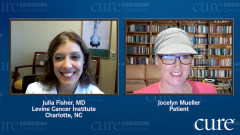
HER2-positive Breast Cancer: Post-Operative Therapies
Dr. Julie Fisher details the therapies used for HER2-positive breast cancer in the post-operative setting, including newly available treatment options, and reviews data supporting the choice of therapy for each patient.
Episodes in this series

Julie Fisher, MD: Typically, once chemotherapy is complete, surgery will take place, and again we’ll continue with HER2-targeted therapy alone. When I keep talking about surgery will determine what we use, it’s back to that complete response versus partial response. We’re going to continue with HER2-targeted therapy for patients who have achieved a partial response. A big study called the KATHERINE trial was published a couple of years ago, and it looked at patients who had partial responses, who had residual disease. They gave those patients a drug called T-DM1 or Kadcyla [trastuzumab emtansine]. It’s essentially trastuzumab linked to a chemotherapeutic agent; I think of it like a Trojan horse. We found that among the patients with partial responses, they did better if they got T-DM1. So for patients who have a partial response, that’s what we’re going to be utilizing in the postoperative setting.
For patients who have a complete response, historically, we continued with the Herceptin [trastuzumab] and Perjeta [pertuzumab]. Again, those are our 2 snipers that we started off with. For many years these were available only in IV [intravenous] formulation, but the FeDeriCa study looked at Phesgo [pertuzumab, trastuzumab, hyaluronidase-zzxf], which is the name brand of a drug that’s a subcutaneous preparation of the Herceptin and Perjeta together. This was FDA approved in mid-2020, and the trial showed that utilizing the subcutaneous formulation versus the IV formulation was equivalent in terms of effectiveness. Later studies demonstrated that patients were happier getting the subcutaneous formulation.
For Jocelyn, we haven’t used that for a couple of reasons. The biggest of which is even though it was FDA [Food and Drug Administration]-approved, it does sometimes take these drugs a little time to get down the pipeline and be offered at various centers. At the time that you initiated treatment, my center was not yet offering Phesgo. I’m happy to report that that has changed, so if that turns out to be the right combination for you postoperatively, that is certainly a preparation that we could consider. The plus side again is it’s an injection underneath the skin, meaning people don’t need IV access. People who are having difficulty with ports or getting IVs don’t need to worry about that, and it’s a much shorter administration. The subcutaneous administration takes only 5 minutes compared to the longer infusion time for the IV preparation.
The only downside, frankly, that I can envision is the perennial issue that we all contend with in our American health care system, and that is that there’s great variability in insurance companies’ willingness to pay for different things. My anticipation now that this drug is available is that it provides another nice opportunity for us to offer something different for patients, assuming we can get it paid for. Genentech thankfully has an Access Solutions entity that can assist people who are having difficulty with that. Again, we will tailor what type of HER2-targeted treatment happens in the postoperative setting based on the operative findings.
Transcript edited for clarity.

